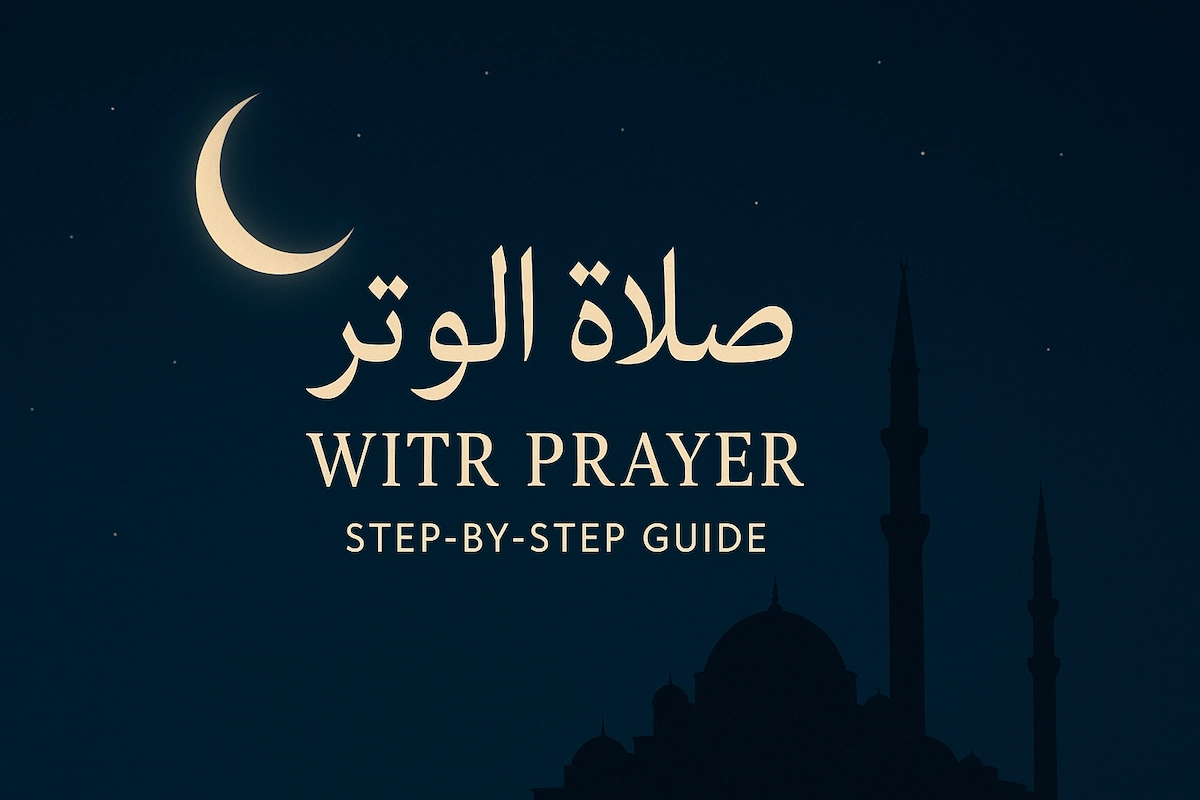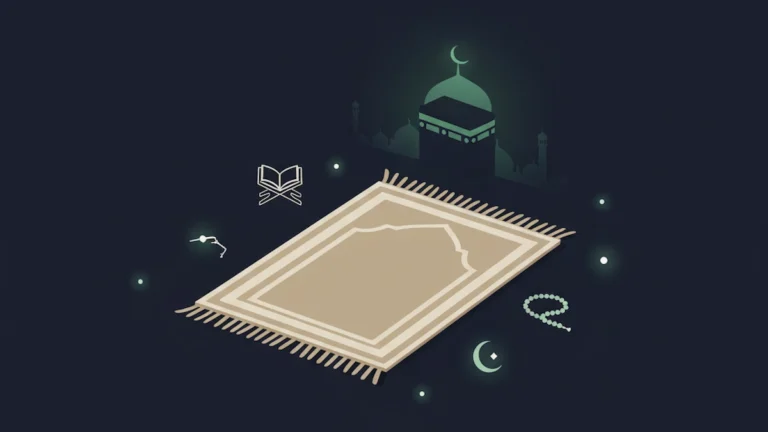The Witr Prayer (Salat al-Witr) is one of the most beloved prayers to Allah ﷻ. The word “Witr” (وتر) in Arabic means odd — because this prayer is always offered in an odd number of rak‘ahs (1, 3, 5, 7, 9, or 11).
The Prophet Muhammad (ﷺ) said:
“Make Witr the last of your night prayers.”
(Sahih Bukhari & Muslim)
This special prayer is offered after the Isha prayer and before Fajr, and it serves as the seal of the night prayers. Every Muslim who performs Isha is encouraged to also offer Witr before sleeping.
See Also: Salah in Islam Step-by-Step Guide
Is Witr Prayer Obligatory (Farz) or Sunnah?
There is a slight difference of opinion among scholars regarding the ruling of Witr:
- Hanafi School: Witr is Wajib (necessary but below the level of Farz).
- Shafi‘i, Maliki, and Hanbali Schools: Witr is Sunnah Mu’akkadah (highly emphasized Sunnah).
The Prophet (ﷺ) never missed Witr — neither at home nor while traveling — which shows its great importance.
Hadith:
“The Witr prayer is a duty for every Muslim. Whoever wishes to pray five rak‘ahs may do so, whoever wishes to pray three may do so, and whoever wishes to pray one may do so.”(Sunan Abu Dawood 1416)
So, although not strictly Farz, Witr is a Sunnah the Prophet (ﷺ) never left, and it completes your day’s worship beautifully.
Timing of Witr Prayer
The time for Witr begins after Isha prayer and lasts until the break of dawn (Fajr).
- You can pray it right after Isha, or
- Delay it to the last part of the night if you wake up for Tahajjud.
Best Time:
“The most virtuous prayer after the obligatory ones is the night prayer.”
(Sahih Muslim 1163)
If you know you’ll wake up for Tahajjud, delay Witr until then — because the Prophet (ﷺ) often prayed Witr as the final act of his night prayers.
But if you fear you won’t wake up later, pray Witr right after Isha before sleeping.
Number of Rak‘ahs in Witr Prayer
The word Witr means “odd,” so the prayer must have an odd number of rak‘ahs.
Common Options:
- 1 Rak‘ah: Minimum Witr
- 3 Rak‘ahs: Most common form
- 5, 7, 9, or 11 Rak‘ahs: For longer night prayers (like the Prophet (ﷺ) did sometimes)
The Most Common Way: 3 Rak‘ahs
There are two ways to perform 3 Rak‘ah Witr:
- Three continuous rak‘ahs (like Maghrib) with one Tashahhud at the end only.
- 2 Rak‘ahs + 1 Rak‘ah separately, as narrated from some companions.
Both are valid. The Hanafi method prefers praying 3 continuous rak‘ahs with Dua-e-Qunoot before Rukoo in the last rak‘ah.
Step-by-Step: How to Perform 3 Rak‘ah Witr Prayer

Step 1: Intention (Niyyah)
Make the intention in your heart:
“I intend to pray three Rak‘ahs of Witr for Allah, facing the Qiblah.”
You can say silently in Arabic (optional):
نَوَيْتُ أَنْ أُصَلِّيَ ثَلَاثَ رَكَعَاتٍ لِلّٰهِ تَعَالٰى وِتْرًا
Step 2: First Rak‘ah
- Say Takbeer (Allahu Akbar) and fold your hands.
- Recite Subhanaka Allahumma… (Thana).
- Recite Surah Al-Fatiha.
- Recite any Surah — commonly Surah Al-A‘la (87).
- Perform Rukoo and Sujood as usual.
Step 3: Second Rak‘ah
- Stand up for the second rak‘ah.
- Recite Surah Al-Fatiha.
- Recite another Surah — commonly Surah Al-Kafirun (109).
- Perform Rukoo and Sujood.
- Do not sit for Tashahhud yet — stand for the third rak‘ah.
Step 4: Third Rak‘ah
- Recite Surah Al-Fatiha.
- Recite another Surah — commonly Surah Al-Ikhlas (112).
- After finishing the recitation, raise your hands and say Takbeer (like at the beginning): “Allahu Akbar”
(then fold hands again) - Recite Dua-e-Qunoot (see below).
- After Dua-e-Qunoot, go into Rukoo and Sujood as normal.
- Sit for Tashahhud, recite At-Tahiyyat, Durood, and Dua, then say Salam to end the prayer.
Read more: Dua-e-Qunoot in Arabic, English
Dua-e-Qunoot (Arabic, Transliteration & Meaning)
Arabic:
اللَّهُمَّ إِنَّا نَسْتَعِينُكَ وَنَسْتَغْفِرُكَ وَنَسْتَهْدِيكَ وَنُؤْمِنُ بِكَ وَنَتَوَكَّلُ عَلَيْكَ وَنُثْنِي عَلَيْكَ الْخَيْرَ وَنَشْكُرُكَ وَلَا نَكْفُرُكَ وَنَخْلَعُ وَنَتْرُكُ مَنْ يَفْجُرُكَ، اللَّهُمَّ إِيَّاكَ نَعْبُدُ وَلَكَ نُصَلِّي وَنَسْجُدُ وَإِلَيْكَ نَسْعَى وَنَحْفِدُ نَرْجُو رَحْمَتَكَ وَنَخَافُ عَذَابَكَ إِنَّ عَذَابَكَ بِالْكُفَّارِ مُلْحَقٌ
Transliteration:
Allahumma inna nasta‘īnuka, wa nastaghfiruka, wa nastahdīka, wa nu’minu bika, wa natawakkalu ‘alayka, wa nuthnī ‘alaykal-khayr, wa nashkuruka wa la nakfuruka, wa nakhla‘u wa natruku man yafjuruk.
Allahumma iyyāka na‘budu, wa laka nusallī wa nasjudu, wa ilayka nas‘ā wa nahfidu, narjū rahmataka, wa nakhāfu ‘adhābak, inna ‘adhābaka bil-kuffāri mulhaq.
English Translation:
“O Allah, we seek Your help, Your forgiveness, and Your guidance.
We believe in You and put our trust in You.
We praise You and thank You, and we do not deny You.
We separate and abandon those who disobey You.O Allah, You alone we worship, and to You we pray and prostrate.
For You we strive and hasten.
We hope for Your mercy and fear Your punishment.
Indeed, Your punishment overtakes the disbelievers.”
Alternative Dua (if you don’t know the full one):
If you haven’t memorized Dua Qunoot yet, you may say any short dua such as:
اللَّهُمَّ اغْفِرْ لِي، وَارْحَمْنِي، وَاهْدِنِي، وَعَافِنِي، وَارْزُقْنِي
Transliteration: Allahummaghfir li, warhamni, wahdini, wa ‘afini, warzuqni
Translation: (O Allah, forgive me, have mercy on me, guide me, grant me health, and provide for me.)
Different Ways to Pray Witr
The Prophet (ﷺ) prayed Witr in different ways on different nights, showing flexibility.
- 1 Rak‘ah: If you prayed Tahajjud earlier in even numbers, you can make it odd with 1 Witr at the end.
- 3 Rak‘ah: Most common and easy.
- 5 or 7 Rak‘ahs: Pray continuously without sitting except in the last rak‘ah.
- 9 or 11 Rak‘ahs: The Prophet (ﷺ) sometimes prayed 11 rak‘ahs including Witr.
The key point is: finish your night prayer with an odd number — that is the essence of Witr.
Common Mistakes in Witr Prayer
- Skipping Witr entirely — despite the Prophet (ﷺ) never missing it.
- Forgetting Dua-e-Qunoot — try to recite at least a short dua.
- Reciting Qunoot after Rukoo — in the Hanafi method, Qunoot is before Rukoo.
- Mixing Witr with Tahajjud incorrectly — Witr should be the last prayer.
- Praying only 2 Rak‘ahs — Witr must be odd (1, 3, 5…).
See Also: Sajda-e-Sahw – Perform the Prostration of Forgetfulness
Virtues and Rewards of Witr Prayer
The Witr prayer holds great virtue and closeness to Allah ﷻ.
Hadith:
“Allah is Witr (One) and loves Witr, so perform Witr, O people of the Qur’an.”
(Sunan Abu Dawood 1416)
“Whoever does not pray Witr is not one of us.”
(Ahmad, Abu Dawood)
“The Witr prayer is a right upon every Muslim.”
(Tirmidhi 453)
Regularly praying Witr keeps your heart spiritually connected and protects your Iman through the night.
Benefits of Performing Witr Prayer
- Closes your day with remembrance of Allah.
- Protects from Shaytan at night.
- Brings peace and tranquility to the heart.
- Builds a stronger connection with Allah.
- Helps maintain discipline in night prayers.
Tips to Never Miss Witr Prayer
- Pray it right after Isha if you’re too tired.
- Set a reminder or alarm for it.
- Keep Dua-e-Qunoot saved on your phone.
- Teach family members to pray Witr together.
- End your day with forgiveness and dua.
See Also: Adhan in Arabic, English Translation
Conclusion
The Witr Prayer is a beautiful Sunnah that strengthens your bond with Allah. It’s a short prayer — but full of blessings, forgiveness, and mercy.
Make it a habit to pray Witr every night — whether you pray 1 rak‘ah or 11 — because it’s the seal of your day’s worship and a sign of faithfulness to the Sunnah.
“The one who prays Witr is not careless; the one who leaves it loses great reward.”
Quick Summary
| Question | Answer |
|---|---|
| When to pray Witr? | After Isha until Fajr |
| How many Rak‘ahs? | 1, 3, 5, 7, 9, or 11 |
| Most common form? | 3 Rak‘ahs |
| Qunoot before or after Rukoo? | Before Rukoo (Hanafi) |
| Is it compulsory? | Wajib (Hanafi), Sunnah (others) |



